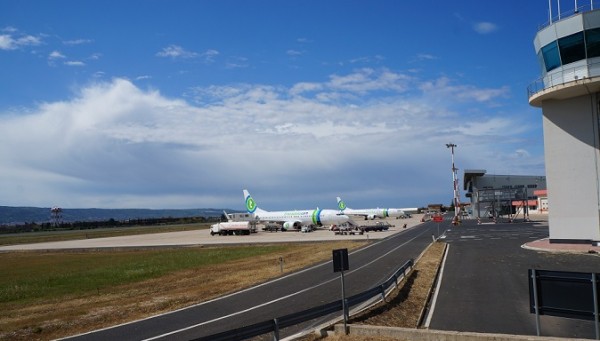by Francesca Piatti
“I am overwhelmed with emotion on learning that the Airport of Comiso will be given the name of Pio La Torre once again, that of the mafia-killed Union Leader and Italian Parlamentarian, whose strong and brave contribution didn’t just start off the struggle against nuclear Missiles in Comiso, but has also been of moral example to all those who believe in peace and Justice, like ourselves,” Luisa Morgantini.
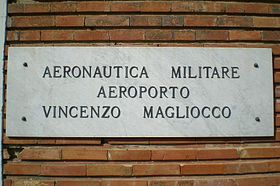
The young Mayor of Comiso, Filippo Spataro from the newspaper pages of La Sicilia of 29/05/2014 has just announced when and where the renaming of the Airport is going to take place. The right name restored to the right place, since this well-known trade-union leader, who was killed by the mafia in ’82, was among the first public figures to understand the dangers connected with the building of this military base and installation of cruise-missiles in Comiso. The appointment will on 7 June 2014 in Comiso Airport, 3rd floor, from 10 a.m. To 2 p.m. The Centro La Torre has olready orginised a bus to take supporters from Palermo to Comiso for a small contribution. Who will be be present at the ceremony? Certainly the Chairman of the Senate, Pietro Grasso and the Minister of Justice, Orlandi, as well as the Chair of the Sicilian Region Rosario Crocetta. The speeches and the debate which shall follow will be on Pio La Torre’s role in Italian history.
This appointment does not just consist of a ceremony through which the Airport is going to get its name back. To be precise, it had been dedicated to La Torre once before, but this name had been removed by the former Comisan Mayor, (of A.N.the ex- right wing party) but there’s much more to that, it is like the final page a lesson in history that is well worth remembering.
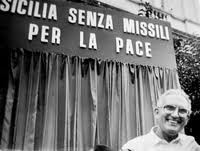 photo by Tano D’Amico
photo by Tano D’Amico
The complicated history of this airport can be summarized in a few pictures with which to narrate what changes the airport has gone through in the course of the last 80 years. First, in 1937, n the middle of the fascist era, the Mussolini government decided to have an airport built in Comiso, in view of the fact that the area was well protected by the Iblean mountains on one hand and also was located near the sea-coast of Vittoria.
The idea was to build a military facilty which would forestall a possible military invasion into Italy by allied forces in Southern Sicily. And that’s how the Comisan people were forced to becoming the unwilling witnesses of endless cement convoys and thousands of workers arriving from a distance to build that base. Tovthem, it was an ominous and tangible sign that the war that was already in the air and was coming on fast… And thus, suddenly the small town was turned into a sitting duck, that an enemy could easily spot and attack in an area where forces were about to gather from many parts of the world. In fact, only a little before the disembarkation of the allies, the airport was savagely flattened with bombs and on 17th June 1943 was occupied by the allied forces and that was how the people of Comiso, who had already seen the presence of the fascists growing and the arrival of the Nazi army, was forced to come to terms also with the new invaders of a different type.
Second, after the end of the war the airport was due to host the 41th Aviation Fleet until 1979, and would later become become an civil airport hosting flights to Palermo and Catania. Third, in 1981, in the middle of the cold war, the Spadolini Government agreed to give the airport over to Nato in order to allow the installation the Cruise Missile ramps. These missiles were going to be 112 and each of these Tomahawks, specially planned to contrast the Russian SS20’s, had the nuclear potential of 6 Hiroshimas each. A whirlwind in a wineglass, rushing into an ancient town, where the women were still cooking bread and meat-pies in their ovens and where workmen were still recruited by the day in the main square, frequented only by men. But the installation was going to be a danger of the whole of Sicily as well, since such missiles were not intended to remain in the silos launching ramps but were to be “disseminated like needles in a haystack” in the whole region carried on of long armoured convoys.
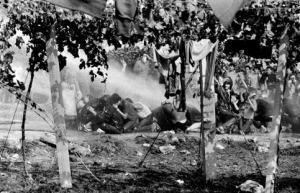 photo by Tano D’Amico
photo by Tano D’Amico
The Comisan People, who until then had been living on agriculture and transport on wheels, on one side were being seduced by the numerous promises circulated by the Nato Force…. that the town would become famous, that dollars would pave the streets and that jobs would become plentiful. All of these promises actually only partly became true: For the enormous Nato Base had been built and programmed it to be self- sufficient, and even the chickens used there were deep frozen and had been carried over from Texas.
Four. After the statement with which the Spadolini Government announced the installation of missiles within a Nato Base, the FGCI (Federation of Communist Italian Youths) started to mobilize and and called up a big demonstration in which a big cake bearing 112 on top of it, a sort of humorous inauguration to the struggle. The cake was duly eaten up, but Nato was going to prove quite hard to take a bite at. Pio La Torre, who had just moved back to Sicily from the capital, strongly encouraged the fight against the militarization of the Sicilian territory and started off a signing campaign against the construction of the base, (one or maybe even two million signatures having been collected).
In the meanwhile, Giacomo Cagnes, a former local Communist leader, founded the CUDIP (Comisan Unitarian Peace Committee) and launched a big peace meeting that was to take place in the month of August ’82, and was going to attract most of the pacifist world, both from Italy and abroad.
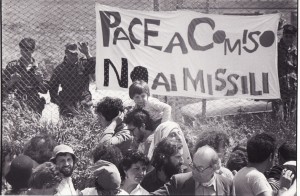 photo by Tano D’Amico
photo by Tano D’Amico
After a one week’s mobilization, featuring trainings, blockades at the airport gate, and demos in town, in the end the pacifists prepared a wall of cardboard boxes, pre-painted up in Piazza FonteDiana (the main square), and erected it right in front of Magliocco Airport, with the slogan of: “Quest’anno di cartone, il prossimo di Persone” (“This year a wall of cardboard, next year, one made of people..).”
This wall was to become the very symbol of the pacifist’s intention to stop vehicles from accessing and taking workers into the airport base.
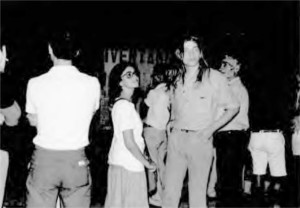
Besides the local pacifists, another staunch group of activists was formed in Comiso. These were young people well versed in methods of nonviolent struggle, and soon about a dozen of them decided to buy a field next to the base starting off with some funds coming from the Anti-war tax objectors. That small area of land was later called the “Verde Vigna” and a subscription was lauched all over Italy to find the necessary funds. The peace Camp itself was named I.P.C ( International Peace Camp) to underline its transnational characteristic feature. On the other side of the airport, a group of separatist women, coming from Italy and abroad, bought another small plot with a tiny house on it , which they then called “La Ragnatela” (The spider’s web): from this they meant to monitor the back area of the airport and the 2nd and 3rd entrances.
Both these presidiums were planned to exist for a long period of time. After Christmas in 1982 a group of workers on redundancy payment from the CISL-UIL trade-union of Milan brought their solidarity to the struggle and helped prepare a long-term resistance. This initial phase was financed by small sums of money coming from support groups of the centre-north of Italy and also with the help of small jobs which the pacifists found locally, such as tomato and pepper-picking in the local hothouses. Fifth, in August ’83 the IMAC Peace Meeting was organized by CUDIP and IPC.
This was planned to be a big peace meeting organized on the side of the airport belonging to the city of Vittoria, which was already a nuclear free zone. Thousands of pacifists convened there from all parts of Europe, and training groups and workshops on passive resistance were organized, as well as workshops of nonviolent techniques and the organization of blockades for all three entrances. These were to be attended by MPs, priests , union members, along with many families and young people and got repressed by the police with the use of batons and of enormous hydrants, all events which got photographed and the pictures which went round the world. The struggle was a hard one, but was being carried with harshness. In the year 1983 eight women of the Ragnatela camp were surprised near the airport, arrested and imprisoned in Ragusa Jail. To help spread the mobilization in their defence, one year later a clamourous action was planned by another 6 Italian women, who managed to enter the base and wrap the soldier guards up in a peace flag. The eight arrested women had actually been thrown out of Italy before the trial, except in the case of a well known pacifist, Anna Luisa Labate, who was a member of the nonviolent movement: She, being was Italian and having to accept the police papers issued to get her out of the way, remained in jail for some time.
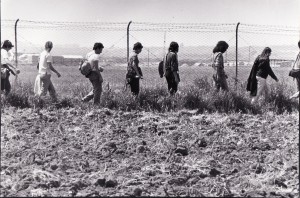
During this period the Italian Communist Party gradually realized that the struggle against the base had few chances of being successful, and therefore slowly lost interest. The CUDIP Peace group continued organizing small demos in town, and Giacomo Cagnes kept on leading small delegations to Hiroshima in Japan every year. On the other hand, the I.P.C. and the Ragnatela Camp continued to obstruct and intercept the exit of Cruise convoys with small unexpected actions and blockades.
By 1984, The owners of the Verde Vigna had become many more than the original thousand, and the Square Metres of Peace were still being sold all over, to activists in England, Germany and also in USA.
Sixth, the episode of the crisis on the Achille Lauro ship took place in the meditteranean, which included an assassination of an Israeli passenger. The Craxi Government, which had jointly carried out the military action to free the ship, refused to hand over armed men to the USA government, and its relations with it it became ice-cold.The USA was now getting aware that the installation of Cruise Missiles and was involving high political and human costs, and probably wasn’t worth the trouble any more.
Later, after the Achille Lauro crisis had blown over, on December 9th 1987, the Italian government said that the Cruise Missiles would be withdrawn from the country. That night there was much rejoicing in the central square of Comiso, fireworks and with famous Journalist Lilly Gruber interviewing the authorities and the IPC members from a platform on a national TV special. The members of the IPC declared that they are going to remain in Comiso and make sure that every single missile has actually been removed, a thing that actually took place only well into 1999.
To say it with Luisa Morgantini’s words: “It is also in memory of Pio La Torre that we must continue to struggle for disarmament and strive to remove every single trace of foreign militarism from our territory and prevent any further attempts to turn Sicily into a military and/or nuclear fortress, for it is one one of the most delicate and vulnerable areas Italy. With all our strength, we must reiterate the demand that the land in Comiso , as well as that of Augusta, of Sigonella and Niscemi shall be used not for death but only life, not with war in mind but in favour of peace and well-being. “Last year a wall of cardboard, this year one built with of people” Comiso, a city of peace. Now and always.


